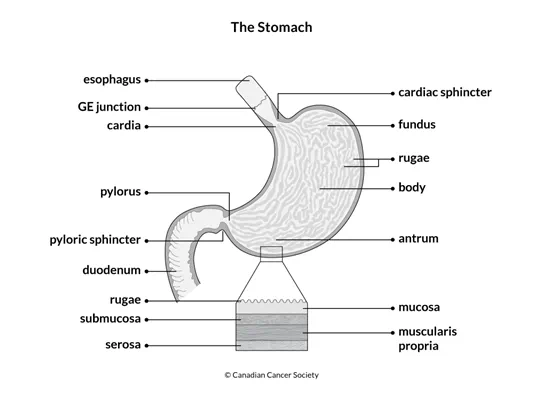Dumping syndrome
Dumping syndrome is a group of symptoms that develops when undigested food moves too fast (or is "dumped") from the stomach into the small intestine. It may also be called rapid gastric emptying.
There are 2 types of dumping syndrome – early and late – depending on how soon it happens after you eat.
Causes
Dumping syndrome can develop after surgery to remove part or all of the stomach.
The pylorus is the narrow, bottom part of the stomach that connects to the

Symptoms
Symptoms of dumping syndrome can vary depending on what you eat. For example, dumping syndrome may be worse after you eat foods that are high in carbohydrates or sugar.
Symptoms also vary if they develop soon after you eat or later. Early dumping syndrome occurs 15 to 60 minutes after you eat. Late dumping syndrome occurs 1 to 3 hours after you eat.
If symptoms get worse or don’t go away, report them to your doctor or healthcare team right away.
Early dumping syndrome
With early dumping syndrome, the stomach releases undigested food into the
- bloating
- abdominal cramping
- diarrhea
- sweating
- dizziness
- early satiety, which is feeling full after eating only a small amount of food
- nausea and vomiting
- flushed skin
-
palpitations , which means that your heart is beating very hard or fast or not beating regularly - headache
- light-headedness, fainting
- wanting to lie down
Late dumping syndrome
Similar to early dumping syndrome, with late dumping syndrome, undigested food is released into the small intestine very quickly. The body quickly absorbs carbohydrates and the blood sugar level rises. The body responds by releasing insulin, which causes a drop in blood sugar level, or hypoglycemia. This can lead to:
- sweating
- shakiness
- hunger
- difficulty concentrating
- feeling less alert
Diagnosis
Your doctor will try to find the cause of dumping syndrome. You may be asked to write down symptoms and when they develop. You may also need to have the following tests:
- glucose challenge, or tolerance, test
- endoscopy
- upper gastrointestinal (GI) series, or barium swallow
- gastric emptying study
A glucose challenge test is used to see how your body reacts to glucose, a type of sugar that is normally found in your blood. You drink a sugary solution. About 1 hour later, your blood sugar level is measured. During this time you will write down any symptoms you have.
Find out more about these tests and procedures.
Managing dumping syndrome
Once the extent of dumping syndrome is known, your healthcare team can suggest ways to manage it. This may include the following.
Dietary changes
It is important to make certain changes to your diet to help manage dumping syndrome. Your healthcare team may recommend that you change your diet:
-
Eat small meals throughout the day rather than 3 larger meals. Eat slowly and chew well.
-
Eat a lower-carbohydrate diet or eat carbohydrates as part of a meal rather than by themselves. Increase how much protein and fat you eat. This will help keep your energy up.
-
Limit how much you drink with a meal. This will help lower the volume in the stomach and reduce the chance of triggering the syndrome.
-
Avoid foods that contain a lot of sugar. Don’t eat chocolate or peppermint. Avoid milk or have only small amounts of it because milk products are usually not well tolerated.
-
Try lying down for 30 minutes after a meal to help delay the stomach emptying its contents. Not eating or drinking after 7:00 p.m. or 8:00 p.m. may also help.
-
Slowly increase the amount of fibre in your diet to help reduce late dumping syndrome. Fibre binds with water to help form stool (poop) and slows the absorption of sugars in the body.
Medicines
If making changes to your diet doesn’t help you manage dumping syndrome, your healthcare team may prescribe these medicines:
-
Acarbose interferes with how your body absorbs carbohydrates. It is given to control blood sugar levels after a meal and help relieve the symptoms of late dumping syndrome.
- Octreotide acetate (Octreotide, Sandostatin, and Sandostatin LAR) slows down how quickly the stomach empties its contents into the small intestine. It is given to limit how much insulin the body releases. It helps control symptoms of both early and late dumping syndrome.
Surgery
Some people may need surgery to change how food moves through the GI tract. But changing your diet and medicines will be tried first. Surgery is only done if these don’t relieve the symptoms of dumping syndrome.
Your trusted source for accurate cancer information
With support from readers like you, we can continue to provide the highest quality cancer information for over 100 types of cancer.
We’re here to ensure easy access to accurate cancer information for you and the millions of people who visit this website every year. But we can’t do it alone.
Every donation helps fund reliable cancer information, compassionate support services and the most promising research. Please give today because every contribution counts. Thank you.
